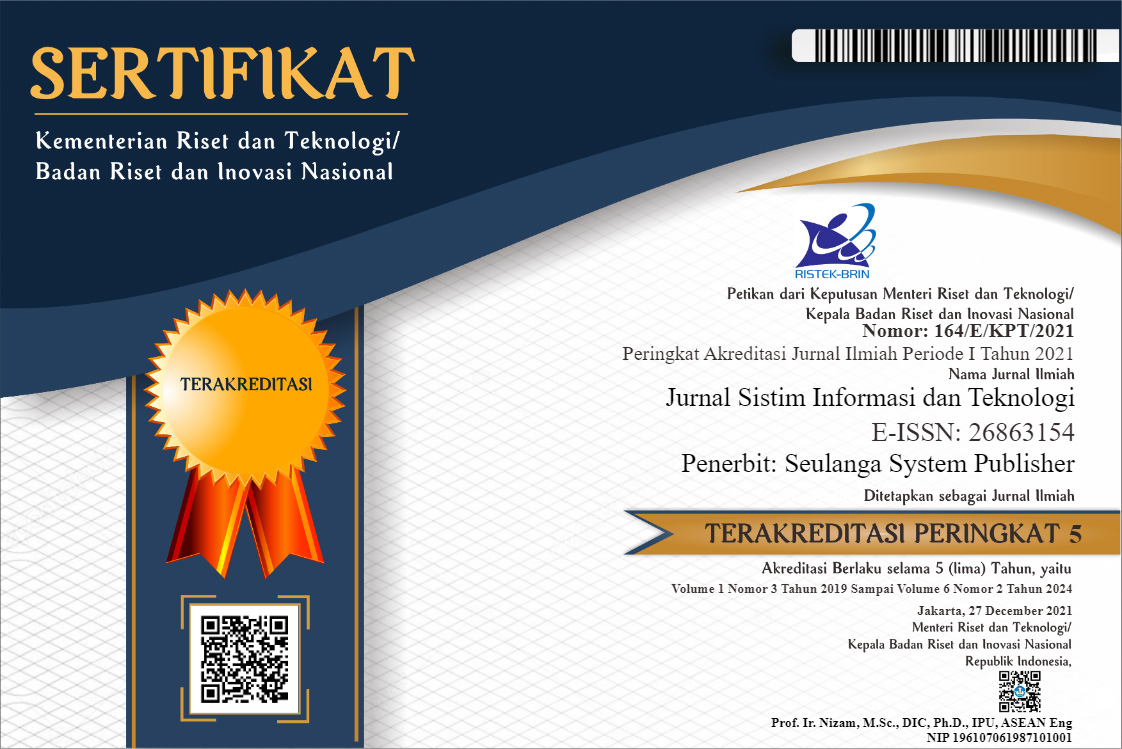Optimalisasi dalam Mengidentifikasi Seleksi Mahasiswa Jalur Cepat (Fast-track) Menggunakan Metode K-Nearest Neighbor
DOI:
https://doi.org/10.37034/jsisfotek.v5i2.166Keywords:
Sistem Pendukung Keputusan (SPK), K-Nearest Neighbor (K-NN), Fast-Track, Data Mining, OptimalisasiAbstract
Penerimaan fast-track dilakukan untuk membantu penyeleksian dalam memberikan rekomendasi mahasiswa yang berpotensi bergabung pada program fast-track maka dibutuhkan Sistem Pendukung Keputusan, dikarenakan sistem penyeleksian calon penerima mahasiswa fast-track masih manual, dan banyak sekali kelemahannya. Banyaknya peminat dalam mendaftar fast-track menyebabkan ketua jurusan mengalami kesusahan saat mengolah data yang manual sehingga dibutuhkan perangkat lunak untuk memudahkan pengolahan data tersebut. Tidak semua mahasiswa yang mengajukan permohonan untuk mendapatkan fast-track dapat disetujui, di karenakan mahasiswa yang mengajukan permohonan cukup banyak, maka begitu dibutuhkan sekali agar dibangun suatu SPK dengan metode K-Nearest Neighbor (K-NN) yang dapat membantu memberikan rekomendasi kepada peminat fast-track. Berdasarkan analisis terhadap SPK dengan metode K-NN ini dilakukan dengan cara observasi wawancara dan implementasi sistem. Dalam penilaian penerimaan fast-track dapat dijadikan dasar untuk memudahkan keputusan pada penyeleksian mahasiswa fast-track karena sistem dapat mengolah data dan menghasilkan informasi secara cepat, tepat dan konsisten kepada ketua jurusan terhadap mahasiswa untuk bergabung fast-track yang akan diberikan. Dapat membentuk suatu keputusan yang tepat, efektif dan efisien pada pengelolaan data seleksi penerimaan fast-track yang memang berpotensi diterima fast-track. Metode K-NN dapat digunakan untuk mengidentifikasi seleksi penerimaan mahasiswa fast-track, SPK dalam penilaian penyeleksian mahasiswa fast-track dapat memudahkan keputusan pada mahasiswa secara proporsional dengan berdasarkan hasil proses data mahasiswa meliputi indeks prestasi mahasiswa semester 1-6, jumlah sks sampai semester 6 dengan tepat dan akurat karena sistem dapat meminimalisir kesalahan dalam proses perhitungan normalisasi data.
References
Aldiabat, K., Alsrayheen, E., Aquino-Russell, C., Al-Qadire, M., Al Rawajfah, O., & Al Sabei, S. D. (2021). Differences in critical thinking skills between nursing students on a fast-track versus traditional 4-year programme. British Journal of Nursing, 30(7), 434–439. https://doi.org/10.12968/bjon.2021.30.7.434
Karo, I. M., Khosuri, A., & Setiawan, R. (2021). Effects of Distance Measurement Methods in K-Nearest Neighbor Algorithm to Select Indonesia Smart Card Recipient. 2021 International Conference on Data Science and Its Applications (ICoDSA), 209–214. https://doi.org/10.1109/ICoDSA53588.2021.9617476
Fitriyadi, F., & Muqorobin, M. (2021). Prediction System for the Spread of Corona Virus in Central Java with K-Nearest Neighbor (KNN) Method. International Journal of Computer and Information System (IJCIS), 2(3), 80–85. https://doi.org/10.29040/ijcis.v2i3.41
Pujianto, U., Rosyid, H. A., & Putra, A. C. (2021). Performance Comparison of Ensemble-based k-Nearest Neighbor and CART Classifiers for the Classification of Adaptive e-learning User Knowledge Levels. https://doi.org/10.2991/assehr.k.211020.037
Priyasadie, N., & Isa, S. M. (2021). Educational Data Mining in Predicting Student Final Grades on Standardized Indonesia Data Pokok Pendidikan Data Set. International Journal of Advanced Computer Science and Applications, 12(12). https://doi.org/10.14569/IJACSA.2021.0121227
Roviani, Supriadi, D., & Iskandar, I. D. (2021). Prediction of Cooperative Loan Feasibility Using the K- Nearest Neighbor Algorithm. Jurnal PILAR Nusa Mandiri, 17(1). https://doi.org/10.33480/pilar.v17i1.2183
Winarti, T., Indriyawati, H., Vydia, V., & Christanto, F. W. (2021). Performance comparison between naive bayes and k- nearest neighbor algorithm for the classification of Indonesian language articles. IAES International Journal of Artificial Intelligence (IJ-AI), 10(2), 452. https://doi.org/10.11591/ijai.v10.i2.pp452-457
Rukmawan, S. H., Aszhari, F. R., Rustam, Z., & Pandelaki, J. (2021). Cerebral Infarction Classification Using the K-Nearest Neighbor and Naive Bayes Classifier. Journal of Physics: Conference Series, 1752(1), 012045. https://doi.org/10.1088/1742-6596/1752/1/012045
Khowarizmi, A., Syah, R., M. Nasution, M. K., & Elveny, M. (2021). Sensitivity of MAPE using detection rate for big data forecasting crude palm oil on k-nearest neighbor. International Journal of Electrical and Computer Engineering (IJECE), 11(3), 2696. https://doi.org/10.11591/ijece.v11i3.pp2696-2703
Effendy, M. H., Anggraeni, D., Dewi, Y. S., & Hadi, A. F. (2022). Classification of Bank Deposit Using Naïve Bayes Classifier (NBC) and K –Nearest Neighbor ( K -NN). https://doi.org/10.2991/acsr.k.220202.031
Theerthagiri, P., Jacob I, J., Ruby A, U., & Yendapalli, V. (2021). Prediction of COVID-19 Possibilities using KNearest Neighbour Classification Algorithm. International Journal of Current Research and Review, 156–164. https://doi.org/10.31782/IJCRR.2021.SP173
Hatem, M. Q. (2022). Skin lesion classification system using a K-nearest neighbor algorithm. Visual Computing for Industry, Biomedicine, and Art, 5(1), 7. https://doi.org/10.1186/s42492-022-00103-6
Geetha, R., Padmavathy, T., & Anitha, R. (2021). Prediction of the academic performance of slow learners using efficient machine learning algorithm. Advances in Computational Intelligence, 1(4), 5. https://doi.org/10.1007/s43674-021-00005-9
Gunawan, G., Hanes, H., & Catherine, C. (2021). C4.5, K-Nearest Neighbor, Naïve Bayes, and Random Forest Algorithms Comparison to Predict Students’ On Time Graduation. Indonesian Journal of Artificial Intelligence and Data Mining, 4(2), 62–71. https://doi.org/https://dx.doi.org/10.24014/ijaidm.v4i2.10833
Rukmana, I., Rasheda, A., Fathulhuda, F., Cahyadi, M. R., & Fitriyani, F. (2021). Analisis Perbandingan Kinerja Algoritma Naïve Bayes, Decision Tree-J48 dan Lazy-IBK. JURNAL MEDIA INFORMATIKA BUDIDARMA, 5(3), 1038-1044. http://dx.doi.org/10.30865/mib.v5i3.3055
Siahaan, A. T. P. A. T., & Turnip, M. (2022). Implementation of Data Mining Using the K-Nearest Neighbor Method to Determine the feasibility of a lecturer’s functional promotion. Journal of Computer Networks, Architecture and High Performance Computing, 4(1), 62–68. https://doi.org/10.47709/cnahpc.v4i1.1242
Marinho, E. P. (2021). Covariance-based smoothed particle hydrodynamics. A machine-learning application to simulating disc fragmentation. arXiv preprint arXiv:2106.08870. https://doi.org/10.48550/arXiv.2106.08870
Onyezewe, A., Kana, A. F., Abdullahi, F. B., & Abdulsalami, A. O. (2021). An Enhanced Adaptive k-Nearest Neighbor Classifier Using Simulated Annealing. International Journal of Intelligent Systems and Applications, 13(1), 34–44. https://doi.org/10.5815/ijisa.2021.01.03
Abuzaraida, M. A., Elmehrek, M., & Elsomadi, E. (2021). Online handwriting Arabic recognition system using k-nearest neighbors classifier and DCT features. International Journal of Electrical and Computer Engineering (IJECE), 11(4), 3584. https://doi.org/10.11591/ijece.v11i4.pp3584-3592 Method. 4th Proc. EECSI. 23-24 Sep. 2017. Yogyakarta: Indonesia. http://dx.doi.org/10.1109/EECSI.2017.8239085
Himeur, Y., Alsalemi, A., Bensaali, F., & Amira, A. (2021). Smart power consumption abnormality detection in buildings using micromoments and improved K‐nearest neighbors. International Journal of Intelligent Systems, 36(6), 2865–2894. https://doi.org/10.1002/int.22404
Downloads
Published
How to Cite
Issue
Section
License
Copyright (c) 2023 Jurnal Sistim Informasi dan Teknologi

This work is licensed under a Creative Commons Attribution 4.0 International License.









